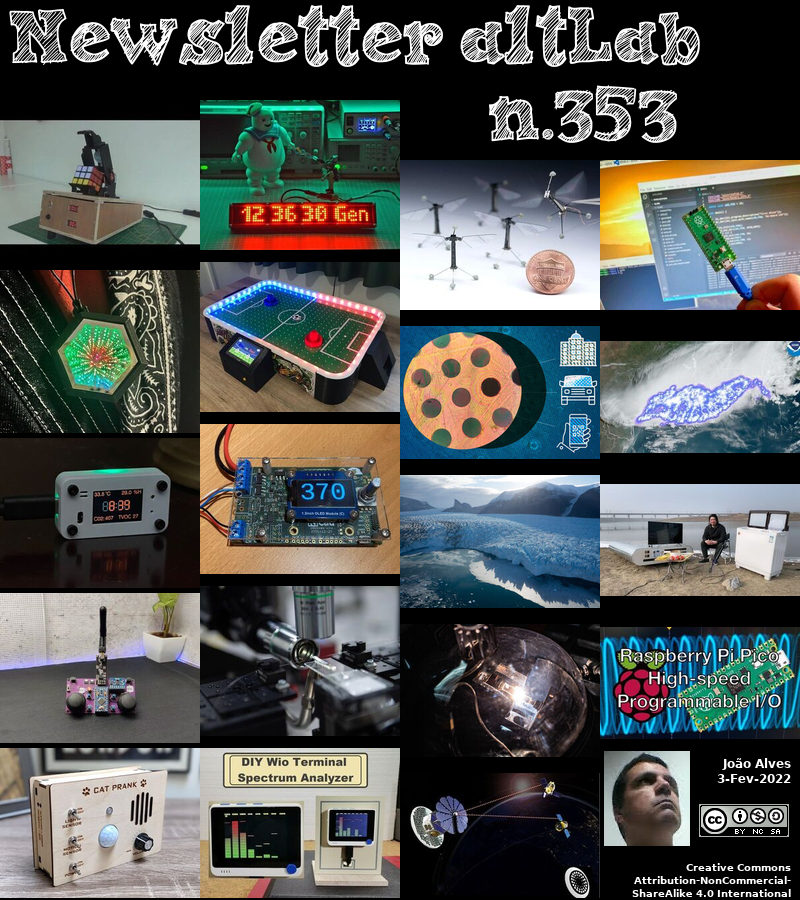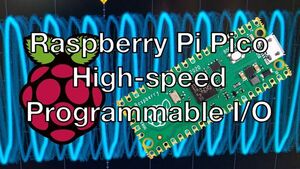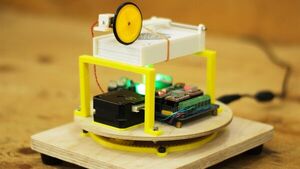2022-02-03 - Nº 353
Editorial
Esta é a Newsletter Nº 353 que se apresenta com o mesmo formato que as anteriores. Se gostar da Newsletter partilhe-a!
Todas as Newsletters encontram-se indexadas no link.
Esta Newsletter tem os seguintes tópicos:
Faz hoje anos que nascia, em 1853, o inventor norte-americano Hudson Maxim. No início da sua carreira, num negócio de impressão em Pittsfield, Mass. (1883), inventou um método de impressão a cores em jornais. Depois voltou-se para a melhoria dos explosivos e fez a primeira pólvora sem fumo nos Estados Unidos. Em 1901, inventou o maximite, um pó altamente explosivo 50% mais potente do que a dinamite. Quando usado em torpedos, maximite resistiu tanto ao choque de disparo como ao maior choque de perfuração da placa de blindagem sem explodir até ser então desencadeado por um fusível detonante de acção retardada, outra invenção de Maxim. Mais tarde, aperfeiçoou um nova pólvora sem fumo, chamado estabilite devido à sua alta estabilidade, e motorite, uma substância auto-combustiva para propulsar torpedos.
Faz também hoje anos que nascia, em 1859, o designer alemão de aviões Hugo Junkers. Ele foi o proponente inicial da construção monoplano e totalmente metálica de aviões. A sua empresa, Junkers Flugzeug- und Motorenwerke AG (Junkers Aircraft and Motor Works), foi um dos pilares da indústria aeronáutica alemã nos anos entre a Primeira Guerra Mundial e a Segunda Guerra Mundial. Os seus aviões multimotores, totalmente metálicos, de passageiros e de carga ajudaram a estabelecer companhias aéreas na Alemanha e em todo o mundo.
Por fim, faz hoje anos que nascia, em 1890, o físico suíço Paul Scherrer. Ele, em colaboração com Peter Debye produziu um método de análise de difracção de raios X. O método Debye-Scherrer tem a capacidade de identificar materiais que não estejam na forma de cristais grandes e perfeitos.
Em 1966, os EUA lançaram o seu primeiro satélite meteorológico operacional, o ESSA-1, para fornecer fotografia de cobertura de nuvens ao Centro Meteorológico Nacional dos EUA para a preparação de análises e previsões meteorológicas operacionais. A nave espacial era um polígono de 18 lados, 42 polegadas de diâmetro, 22 polegadas de altura e peso 305 lb. Era feita de liga de alumínio e aço inoxidável, depois coberta com 9100 células solares. As células solares serviram para carregar as 63 baterias. As suas duas câmaras foram montadas 180 graus uma contra a outra ao longo do lado cilíndrico da embarcação. Uma câmara podia ser apontada em algum ponto da Terra sempre que o satélite girasse ao longo do seu eixo. A ESSA-1 conseguia ver o tempo de cada área do globo, fotografando uma determinada área exactamente à mesma hora local todos os dias.
Também em 1966, e três dias após a sua descolagem, a nave espacial soviética Lunik 9 não tripulada aterrou em segurança na Lua, no Oceano das Tempestades. Foi a primeira aterragem suave de sempre noutro corpo celeste, e abriu o caminho para viagens tripuladas à Lua, eliminando dúvidas de que a superfície fosse uma areia movediça empoeirada e insegura. Ao atingir a superfície, a sonda soviética ejectou uma cápsula de 250 lb que depois rolou na vertical e desdobrou quatro pétalas accionadas por mola para se estabilizar. Uma câmara de televisão com um sistema de espelho rotativo permitiu à Lunik 9 tirar fotografias, incluindo vistas panorâmicas da paisagem lunar e vistas mais próximas das rochas próximas, que foram transmitidas de volta à terra até 6 de Fevereiro, quando as baterias se esgotaram e o contacto com a nave espacial se perdeu.
E nesta semana que passou foi lançado oficialmente a versão de 64-bits do Raspberry OS. A arquitectura ARMv8-A, que engloba a arquitectura AArch64 de 64 bits e o conjunto de instruções A64 associado, foi introduzida pela primeira vez na linha Raspberry Pi com Raspberry Pi 3 em 2016. A partir daí, foi possível executar um sistema operativo completo de 64-bit, e muitos sistemas operativos de terceiros estão disponíveis. Contudo, continuaram a construir os lançamentos Raspberry Pi OS na plataforma 32-bit Raspbian, com o objectivo de maximizar a compatibilidade entre dispositivos e de evitar a confusão dos clientes. Com este lançamento é possível tirar partido da arquitectura de 64-bits, que é mais util nos modelos com 4 ou 8GB de memória RAM.
Na Newsletter desta semana apresentamos diversas noticias, artigos científicos, projetos de maker e alguns vídeos interessantes.
 João Alves ([email protected])
João Alves ([email protected])
O conteúdo da Newsletter encontra-se sob a licença  Creative Commons Attribution-NonCommercial-ShareAlike 4.0 International License.
Creative Commons Attribution-NonCommercial-ShareAlike 4.0 International License.
Novidades da Semana

Raspberry Pi OS (64-bit)
"Over the past year, we’ve been trialling a beta of Raspberry Pi OS in glorious 64-bit. Now it’s time to open it up to a wider audience. The ARMv8-A architecture, which encompasses the 64-bit AArch64 architecture and associated A64 instruction set, was first introduced into the Raspberry Pi line with Raspberry Pi 3 in 2016. From that point on, it has been possible to run a full 64-bit operating system on our flagship products, and many third-party operating systems are available. However, we have continued to build our Raspberry Pi OS releases on the 32-bit Raspbian platform, aiming to maximise compatibility between devices and to avoid customer confusion. As you can see from the table above, it is easy to be confused about which products will support which Debian/Raspbian ports." [...]
Outras Notícias

Almost 500-mile-long lightning bolt crossed three US states
"An almost 500-mile long bolt of lightning that lit up the sky across three US states has set a new world record for longest flash, scientists have confirmed. The bolt in 2020, extended a total of 477.2 miles (768 km) and spread across Mississippi, Louisiana, and Texas. The previous record was 440.6 miles (709 km) and recorded in Brazil in 2018. Lightning rarely extends over 10 miles and usually lasts under a second. Another lightning flash recorded in 2020 - in Uruguay and Argentina - has also set a new record for duration at 17.1 seconds. The previous record was 16.7 seconds." [...]
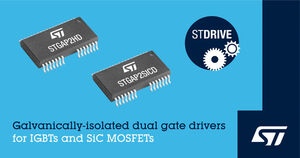
Dual Gate Drivers from STMicroelectronics Optimize and Simplify SiC and IGBT Switching Circuits
"Two new dual-channel galvanically-isolated gate drivers for IGBTs and silicon-carbide (SiC) MOSFETs from STMicroelectronics save space and ease circuit design in high-voltage power-conversion and industrial applications. The STGAP2HD for IGBTs and STGAP2SICD for SiC MOSFETs leverage ST’s latest galvanic-isolation technology to provide 6kV transient-voltage capability in a SO-36W wide-body package. In addition, ±100V/ns dv/dt transient immunity prevents spurious turn-on in electrically noisy operating conditions. The devices can deliver a powerful gate-control signal of up to 4A, with dual output pins for extra flexibility in gate driving, allowing independent adjustment of turn-on and turn-off times. The active Miller clamp prevents gate spikes during fast commutation in half-bridge topologies. Circuit protection features include thermal protection, a watchdog for safe operation, and Under-Voltage Lockout (UVLO) per channel to prevent starting-up in a dangerous low-efficiency mode." [...]

Panasonic Commercializes a Small Power Inductor of 4 mm by 4 mm Square for Automotive Use
"Panasonic Corporation announced today that its Industry Company has commercialized a small power inductor[1] (4 mm by 4 mm square) for automotive use that enables higher performance and downsizing of electronic control units (ECU) for advanced drive assistance systems (ADAS) and autonomous driving systems, with the ability to withstand harsh environment. Mass production of the power inductor will start in May 2022. As the computerization of cars advances, ECUs are now incorporated in many cars. ADAS and autonomous driving require a number of ECUs capable of highly efficient control over cars, with such ECUs requiring small and high-performance power inductors free from connection failures. The company has commercialized a small power inductor of 4 mm by 4 mm square for automotive use to address these needs. It is manufactured with a molding technology where the power inductor is completely filled with a melted metal composite material[2], and is highly resistant to vibrations, thereby preventing crack formation." [...]
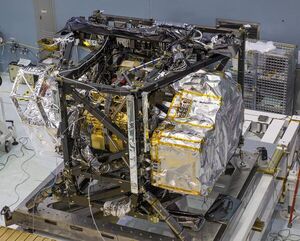
Following Webb’s Arrival at L2, Telescope Commissioning Set to Begin
"Following Webb’s arrival at its orbital destination around Lagrange Point 2 (L2) on Jan. 24, the mission operations team began working its way through a critical series of steps: powering on all the science instruments, turning off heaters to begin a long cooldown process, and ultimately capturing the first photons on Webb’s primary camera to enable a months-long alignment of the telescope. While the MIRI instrument and some instrument components were powered on in the weeks after Webb’s Dec. 25 launch, the team didn’t finish turning on the remaining three instruments – NIRCam, NIRSpec, and FGS/NIRISS – until the past few days. The mission operations team’s next major step is to turn off instrument heaters. The heaters were necessary to keep critical optics warm to prevent the risk of water and ice condensation. As the instruments meet pre-defined criteria for overall temperatures, the team is shutting off these heaters to allow the instruments to restart the months-long process of cooling to final temperatures. When NIRCam reaches 120 kelvins (approximately -244 degrees Fahrenheit, or -153 degrees Celsius), Webb’s optics team will be ready to begin meticulously moving the 18 primary mirror segments to form a single mirror surface." [...]

Multilingual blink for Raspberry Pi Pico
"A year ago today we launched our Raspberry Pi Pico board, the first product powered by the RP2040 microcontroller, a brand-new chip developed right here at Raspberry Pi. A year later we’ve sold nearly 1.5 million Picos, and thousands of you have used RP2040 in your own electronic projects and products. A lot has happened over the last year, and everyone here at Pi Towers has their own list of favourite projects and products they’ve seen or played with. With the launch of Raspberry Pi Direct on Monday we’re sure to see a lot more really soon. So if you’re interested in getting started with RP2040 in hardware you should go read the “Hardware design with RP2040” and take a look at the associated minimal viable design. While there is a growing hardware ecosystem around the RP2040, it’s been really interesting to see a software ecosystem grow alongside it." [...]

Slackware Release Announcement
"Well folks, in spite of the dire predictions of YouTube pundits, this morning the Slackhog emerged from its development den, did *not* see its shadow, and Slackware 15.0 has been officially released - another six weeks (or years) of the development treadmill averted. This has been an interesting development cycle (in the "may you live in interesting times" sense). Anyone who has followed Linux development over the years has seen the new technology and a slow but steady drift away from the more UNIX-like structure. The challenge this time around was to adopt as much of the good stuff out there as we could without changing the character of the operating system. Keep it familiar, but make it modern. And boy did we have our work cut out for us." [...]
Ciência e Tecnologia
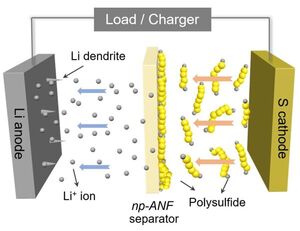
1,000-cycle lithium-sulfur battery could quintuple electric vehicle ranges
"A new biologically inspired battery membrane has enabled a battery with five times the capacity of the industry-standard lithium ion design to run for the thousand-plus cycles needed to power an electric car. A network of aramid nanofibers, recycled from Kevlar, can enable lithium-sulfur batteries to overcome their Achilles heel of cycle life—the number of times it can be charged and discharged—a University of Michigan team has shown. “There are a number of reports claiming several hundred cycles for lithium-sulfur batteries, but it is achieved at the expense of other parameters—capacity, charging rate, resilience and safety. The challenge nowadays is to make a battery that increases the cycling rate from the former 10 cycles to hundreds of cycles and satisfies multiple other requirements including cost,” said Nicholas Kotov, the Irving Langmuir Distinguished University Professor of Chemical Sciences and Engineering, who led the research. “Biomimetic engineering of these batteries integrated two scales—molecular and nanoscale. For the first time, we integrated ionic selectivity of cell membranes and toughness of cartilage." [...]
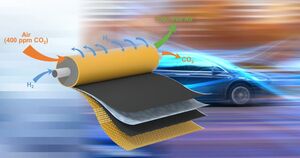
Short Circuit For Big Impact
"UD researchers report hyper-efficient method for removing carbon dioxide from air University of Delaware engineers have demonstrated a way to effectively capture 99% of carbon dioxide from air using a novel electrochemical system powered by hydrogen. It is a significant advance for carbon dioxide capture and could bring more environmentally friendly fuel cells closer to market. The research team, led by UD Professor Yushan Yan, reported their method in Nature Energy on Thursday, February 3. Game-changing tech for fuel cell efficiency Fuel cells work by converting fuel chemical energy directly into electricity. They can be used in transportation for things like hybrid or zero-emission vehicles. Yan, Henry Belin du Pont Chair of Chemical and Biomolecular Engineering, has been working for some time to improve hydroxide exchange membrane (HEM) fuel cells, an economical and environmentally friendly alternative to traditional acid-based fuel cells used today." [...]
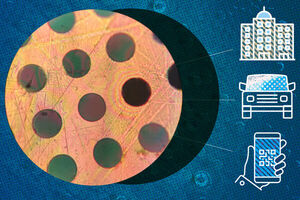
New lightweight material is stronger than steel
"The new substance is the result of a feat thought to be impossible: polymerizing a material in two dimensions. Using a novel polymerization process, MIT chemical engineers have created a new material that is stronger than steel and as light as plastic, and can be easily manufactured in large quantities. The new material is a two-dimensional polymer that self-assembles into sheets, unlike all other polymers, which form one-dimensional, spaghetti-like chains. Until now, scientists had believed it was impossible to induce polymers to form 2D sheets. Such a material could be used as a lightweight, durable coating for car parts or cell phones, or as a building material for bridges or other structures, says Michael Strano, the Carbon P. Dubbs Professor of Chemical Engineering at MIT and the senior author of the new study. “We don’t usually think of plastics as being something that you could use to support a building, but with this material, you can enable new things,” he says." [...]

Superconductor Simulations: Algorithms Predict Superconductivity in Crystalline Materials
"Superconductivity is a phenomenon where a material loses its electrical resistance. However, it occurs at extremely low transition temperatures requiring expensive cooling solutions. A breakthrough in high-temperature superconductors was found in crystal structures containing hydrogen. Now, researchers have used a supercomputer to predict new candidates among such hydrogen-containing crystalline materials. Their simulations reveal certain structures to display superconductivity getting closer to room temperature. High-temperature superconductivity allows the development of energy-efficient devices without the need for expensive cooling solutions." [...]

DNA sample analysis times dramatically reduced thanks to new file format
"Nanopore sequence analysis can now be done more than 30 times faster, providing quicker and better specialised treatments for patients with cancer and other diseases. A new computer file format which helps process DNA samples 30 times faster than existing systems has been developed by teams at UNSW and the Garvan Institute of Medical Research. The SLOW5 format has been specifically designed to more efficiently analyse nanopore sequences, which provide a more complete view of genetic variations. The improved efficiency not only helps medical experts analyse individual DNA samples much more quickly and provide faster and better healthcare to patients, but also allows more sampling in any given period. The research behind the development has been published in Nature Biotechnology, but the software has already been made available through open source and has been downloaded more than 1000 times in just a few weeks. The complex nature of nanopore sequencing of DNA means huge amounts of data are created which then needs to be stored and properly analysed." [...]
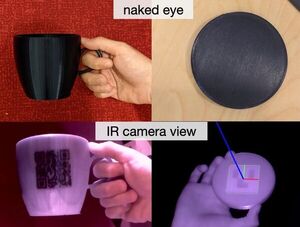
Invisible machine-readable labels that identify and track objects
"If you download music online, you can get accompanying information embedded into the digital file that might tell you the name of the song, its genre, the featured artists on a given track, the composer, and the producer. Similarly, if you download a digital photo, you can obtain information that may include the time, date, and location at which the picture was taken. That led Mustafa Doga Dogan to wonder whether engineers could do something similar for physical objects. “That way,” he mused, “we could inform ourselves faster and more reliably while walking around in a store or museum or library.” The idea, at first, was a bit abstract for Dogan, a 4th-year PhD student in the MIT Department of Electrical Engineering and Computer Science. But his thinking solidified in the latter part of 2020 when he heard about a new smartphone model with a camera that utilizes the infrared (IR) range of the electromagnetic spectrum that the naked eye can’t perceive. IR light, moreover, has a unique ability to see through certain materials that are opaque to visible light." [...]

Robotic Exploration of Uncharted, Underwater Glacial Walls Set for 2023
"It’s the front line of climate change and could hold the key to predicting global sea level rise, but what goes on at the underwater face of Greenland’s glaciers is a mystery to science. That could change in 2023 with a bold new mission led by researchers at The University of Texas at Austin that will explore three of Greenland’s glaciers with a submersible robot. The voyage will be the first time Greenland’s glaciers — which make up the world’s second-largest ice sheet — will be seen up close underwater. Engineered to survive ice-covered seas by project partner the Woods Hole Oceanographic Institution (WHOI), the remotely operated vehicle Nereid Under Ice (NUI) will brave icebergs and riptides to approach within feet of the glaciers and return with data and samples from their underwater environment. The scientists’ primary focus is not glacial ice, but the natural sand walls — or moraines — that buttress the glaciers and are thought to naturally, but precariously, stabilize the ice sheet. What they learn will reveal what’s shoring up glaciers across the entire Greenland ice sheet, which could lead to more accurate model projections for future sea level rise." [...]
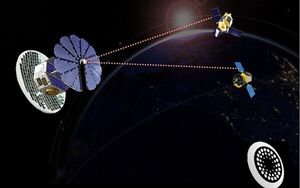
Surrey researchers working with Space Power to revolutionise satellite power using laser beaming
"The University of Surrey and Space Power are tackling the problem of powering satellites in Low Earth Orbit (LEO) during their eclipse period when they cannot see the sun. By collaborating on a space infrastructure project, the joint team will develop new technology which uses lasers to beam solar power from satellites under solar illumination to small satellites orbiting closer to Earth during eclipse. The wireless, laser-based power beaming prototype will be the first developed outside of governmental organisations and is aiming for commercialisation by 2025. Wireless power beaming is a critical and disruptive technology for space infrastructure and will provide auxiliary power to increase the baseline efficiency of small satellites in LEO. The technical side of the project will use the highly specialised laser laboratories and optical systems developed at the University of Surrey’s Department of Physics and Advanced Technology Institute, which are world leaders in the development and implementation of laser and photovoltaic-based technologies. The first Space Power product will be designed as a plug-and-play system for satellite manufacturers to include in their offering to their LEO constellation customers." [...]

A new method for quantum computing
"Physicists from the University of Amsterdam have proposed a new architecture for a scalable quantum computer. Making use of the collective motion of the constituent particles, they were able to construct new building blocks for quantum computing that pose fewer technical difficulties than current state-of-the art methods. The results were recently published in Physical Review Letters. The researchers work at QuSoft and the Institute of Physics in the groups of Rene Gerritsma and Arghavan Safavi-Naini. The effort, which was led by the PhD candidate Matteo Mazzanti, combines two important ingredients. One is a so-called trapped-ion platform, one of the most promising candidates for quantum computing that makes use of ions – atoms that have either a surplus or a shortage of electrons and as a result are electrically charged." [...]

Providing GPS-quality timing accuracy without GPS
"DARPA seeks to transition precision optical atomic clocks from laboratory to warfighter. Synchronizing time in modern warfare – down to billionths and trillionths of a second – is critical for mission success. High-tech missiles, sensors, aircraft, ships, and artillery all rely on atomic clocks on GPS satellites for nanosecond timing accuracy. A timing error of just a few billionths of a second can translate to positioning being off by a meter or more. If GPS were jammed by an adversary, time synchronization would rapidly deteriorate and threaten military operations. To address this scenario, DARPA has announced the Robust Optical Clock Network (ROCkN) program, which aims to create optical atomic clocks with low size, weight, and power (SWaP) that yield timing accuracy and holdover better than GPS atomic clocks and can be used outside a laboratory." [...]

Quantum leap on film
"An ultra-fast microscope combines atomic spatial and temporal resolution and thus enables unprecedented insights into the dynamics of electrons in molecules In order to better understand (and possibly control) fast chemical reactions, it is necessary to study the behaviour of electrons as precisely as possible – in both space and time. However, up to now, microscopy methods have delivered only either spatially or temporally sharp images. By cleverly combining established techniques of tunnelling microscopy and laser spectroscopy, a team led by Klaus Kern, Director at the Max Planck Institute for Solid State Research in Stuttgart, has now overcome these obstacles. Using their atomic quantum microscope, they can make the movement of electrons in individual molecules visible. It is essential not only for understanding biological processes (e.g. plant photosynthesis) to map the electron dynamics in molecules but also for many technical applications such as the development of solar cells or new types of electronic components." [...]
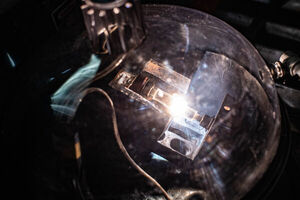
Machine learning fine-tunes flash graphene
"Rice University scientists are using machine-learning techniques to streamline the process of synthesizing graphene from waste through flash Joule heating. The process discovered two years ago by the Rice lab of chemist James Tour has expanded beyond making graphene from various carbon sources to extracting other materials like metals from urban waste, with the promise of more environmentally friendly recycling to come. The technique is the same for all of the above: blasting a jolt of high energy through the source material to eliminate all but the desired product. But the details for flashing each feedstock are different. The researchers describe in Advanced Materials how machine-learning models that adapt to variables and show them how to optimize procedures are helping them push forward. “Machine-learning algorithms will be critical to making the flash process rapid and scalable without negatively affecting the graphene product’s properties,” Tour said." [...]
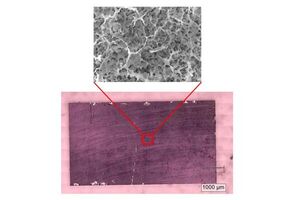
2D material in three dimensions
"How do you integrate as much as possible of the 2D material graphene into a limited space? By producing it not on a flat surface, but on a 3D nanostructure. The carbon material graphene has no well-defined thickness, it merely consists of one single layer of atoms. It is therefore often referred to as a "two-dimensional material". Trying to make a three-dimensional structure out of it may sound contradictory at first, but it is an important goal: if the properties of the graphene layer are to be exploited best, then as much active surface area as possible must be integrated within a limited volume. The best way to achieve this goal is to produce graphene on complex branched nanostructures." [...]

Molecular machine in nano cage
"What a toy: a tiny gyroscope that would fit in a human cell and that can be controlled from the outside. In cooperation with an international team at the Institute for Basic Science in South Korea, theoretical chemists Dr. Chandan Das and Professor Lars Schäfer from Ruhr-Universität Bochum (RUB) have constructed a molecular gyroscope that can be controlled remotely by light. They also succeeded in characterising the rotational movements of this synthetic nanomachine with computer simulations. The authors describe their findings in the journal “Chem”, published online on 18 January 2022. Navigating aircrafts and satellites Machines enclosed in a cage or casing may display interesting properties. For example, they can convert their energy input into programmed functions." [...]
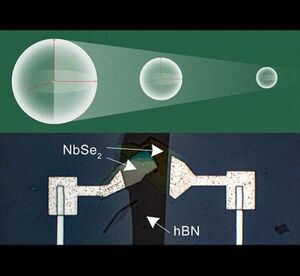
Tiny materials lead to a big advance in quantum computing
"Using ultrathin materials to reduce the size of superconducting qubits may pave the way for personal-sized quantum devices. Like the transistors in a classical computer, superconducting qubits are the building blocks of a quantum computer. While engineers have been able to shrink transistors to nanometer scales, however, superconducting qubits are still measured in millimeters. This is one reason a practical quantum computing device couldn’t be miniaturized to the size of a smartphone, for instance. MIT researchers have now used ultrathin materials to build superconducting qubits that are at least one-hundredth the size of conventional designs and suffer from less interference between neighboring qubits. This advance could improve the performance of quantum computers and enable the development of smaller quantum devices." [...]
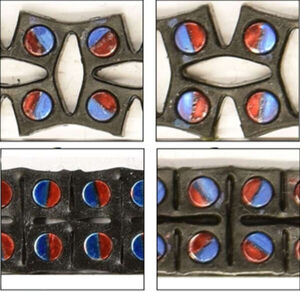
Scientists At Umass Amherst Engineer New Material That Can Absorb And Release Enormous Amounts Of Energy
"A team of researchers from the University of Massachusetts Amherst recently announced in the Proceedings of the National Academy of Sciences that they had engineered a new rubber-like solid substance that has surprising qualities. It can absorb and release very large quantities of energy. And it is programmable. Taken together, this new material holds great promise for a very wide array of applications, from enabling robots to have more power without using additional energy, to new helmets and protective materials that can dissipate energy much more quickly. “Imagine a rubber band,” says Alfred Crosby, professor of polymer science and engineering at UMass Amherst and the paper’s senior author. “You pull it back, and when you let it go, it flies across the room." [...]
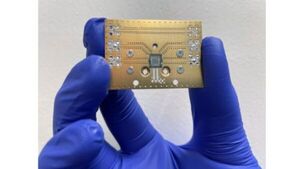
Researchers set record by preserving quantum states for more than 5 seconds
"Breakthrough using common material could pave way for new quantum technologies. Quantum science holds promise for many technological applications, such as building hackerproof communication networks or quantum computers that could accelerate new drug discovery. These applications require a quantum version of a computer bit, known as a qubit, that stores quantum information. But researchers are still grappling with how to easily read the information held in these qubits and struggle with the short memory time, or coherence, of qubits, which is usually limited to microseconds or milliseconds. A team of researchers at the U.S. Department of Energy’s (DOE) Argonne National Laboratory and the University of Chicago have achieved two major breakthroughs to overcome these common challenges for quantum systems. They were able to read out their qubit on demand and then keep the quantum state intact for over five seconds — a new record for this class of devices." [...]
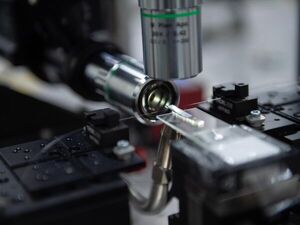
Scientists develop ‘exceptional’ surface to explore exotic physics
"Experimental solution provides first observation of previously theoretical light absorption. By demonstrating exceptional control of an open optical system, an international research team has provided a path to experimentally measure and test exotic phenomena and gain insights into new physics with exquisite sensitivity. Reported in Nature Communications, the Penn State, Michigan Technological University and Vienna University of Technology researchers created a stable surface of ‘exceptional’ points — notoriously finicky singularities that exhibit peculiar properties — and used it to facilitate and observe the perfect absorption of light in a coherent, chiral system. When light enters the system, which operates as a surface full of exceptional points, in one direction, the light is completely absorbed. When entering from the opposite direction, relatively little light is absorbed. “Our work points the way towards interesting new physics with exceptional points beyond their traditional habitat in sensing and lasing, where many more insights can be expected,” said corresponding author Şahin Özdemir, associate professor of engineering science and mechanics at Penn State." [...]
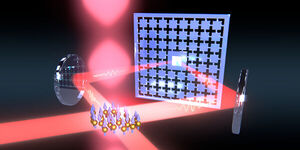
Cooling matter from a distance
"Researchers from the University of Basel have succeeded in forming a control loop consisting of two quantum systems separated by a distance of one meter. Within this loop, one quantum system — a vibrating membrane — is cooled by the other — a cloud of atoms, and the two systems are coupled to one another by laser light. Interfaces such as this allow different kinds of quantum systems to interact with one another even over relatively large distances and will play a key role in quantum technologies of the future. We’ve all experienced the principle of feedback — for example, when we use a thermostat in conjunction with a heating system to regulate indoor temperature. The thermostat measures the current temperature, compares it with the target value and regulates the flow of heat accordingly. Control loops of this kind appear in many areas of everyday life and technology." [...]

Bristol scientists develop insect-sized flying robots with flapping wings
"A new drive system for flapping wing autonomous robots has been developed by a University of Bristol team, using a new method of electromechanical zipping that does away with the need for conventional motors and gears. This new advance, published today in the journal Science Robotics, could pave the way for smaller, lighter and more effective micro flying robots for environmental monitoring, search and rescue, and deployment in hazardous environments. Until now, typical micro flying robots have used motors, gears and other complex transmission systems to achieve the up-and-down motion of the wings. This has added complexity, weight and undesired dynamic effects. Taking inspiration from bees and other flying insects, researchers from Bristol’s Faculty of Engineering, led by Professor of Robotics Jonathan Rossiter, have successfully demonstrated a direct-drive artificial muscle system, called the Liquid-amplified Zipping Actuator (LAZA), that achieves wing motion using no rotating parts or gears. The LAZA system greatly simplifies the flapping mechanism, enabling future miniaturization of flapping robots down to the size of insects." [...]

Novel printing process switches materials from black to transparent
"EPFL researchers have developed a new type of printing process that involves removing material rather than depositing it. Their method could be particularly useful for printing banknotes and ID documents, for example. “We’ve developed an entirely new printing process, turning Guttenberg’s concept on its head,” says Prof. Olivier Martin, head of the Nanophotonics and Metrology Laboratory at EPFL’s School of Engineering. Martin proudly displays a representation of EPFL’s logo produced using his team’s breakthrough method. The letters in the logo are transparent, while their edges are black or aluminum-colored. The researchers’ initial goal was to develop a material that absorbs light completely." [...]

RoboBee Can Now Pivot on a Dime
"This article is part of our exclusive IEEE Journal Watch series in partnership with IEEE Xplore. Since becoming the first insect-inspired robot to take flight, Harvard University’s famous little robotic bee, dubbed RoboBee, has achieved novel perching, swimming, and sensing capabilities, among others. More recently RoboBee has hit another milestone: precision control over its heading and lateral movement, making it much more adept at maneuvering. As a result, RoboBee can hover and pivot better in midair, more similarly to its biological inspiration, the bumblebee. The advancement is described in a study published this past December in IEEE Robotics and Automation Letters. The higher level of control over flight will be beneficial in a wide range of scenarios where precision flight is needed." [...]

New Super-Conducting Technology Takes Data Beyond Zeroes And Ones
"Leveraging electron spin adds a new dimension to data encoding. Remember flip-phones? Our smartphones may one day look just as obsolete thanks to spintronics, an incipient field of research promising to revolutionize the way our electronic devices send and receive signals. In most current technologies, data is encoded as a zero or a one, depending on the number of electrons that reach a capacitor. With spintronics, data is also transferred according to the direction in which these electrons spin. In a new study appearing this week in the Proceedings of the National Academy of Sciences, a team of Duke University and Weizmann Institute researchers led by Michael Therien, professor of Chemistry at Duke, report a keystone achievement in the field: the development of a conducting system that controls the spin of electrons and transmits a spin current over long distances, without the need for the ultra-cold temperatures required by typical spin-conductors." [...]
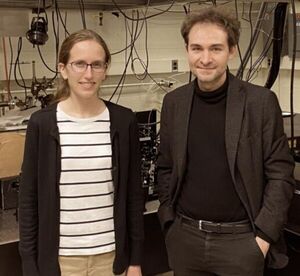
Physicists manipulate magnetism with light
"Work has potential applications in memory storage and demonstrates a rare form of matter With the help of a “playground” they created for observing exotic physics, MIT scientists and colleagues have not only found a new way to manipulate magnetism in a material with light but have also realized a rare form of matter. The former could lead to applications including computer memory storage devices that can read or write information in a much faster way, while the latter introduces new physics. A solid material is composed of different types of elementary particles, such as protons and neutrons. Also ubiquitous in such materials are “quasiparticles” that the public is less familiar with. These include excitons, which are composed of an electron and a “hole,” or the space left behind when light is shone on a material and energy from a photon causes an electron to jump out of its usual position. Through the mysteries of quantum mechanics, however, the electron and hole are still connected and can “communicate” with each other through electrostatic interactions." [...]
Projetos Maker
Diversos Projetos interessantes.
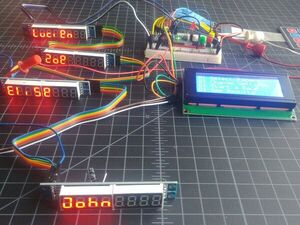
Arduino Race Timer, Lap Counter, and Controller
"Race controller for slot car or drone racing with dedicated racer gates. Cheap, portable, accurate, and easy to build. This is an Arduino based project that implements an inexpensive, reliable, race game controller that can be used for timed racing games. The system consists of a main LCD display, a keypad for user input and menu selection, an 8 digit LED lap count & timer display for each racer, and non-blocking audio for UI feedback and playing a unique victory song for each racer. In the presented configuration, the lap sensing input is simulated using buttons, but can be adapted to be used with a myriad of simple, circuit completion, or other type sensing methods that can be implemented in the physical lap gate. The working demo of this project uses two paper clips integrated into a mechanical lap counter to create a simple, yet effective lap sensor." [...]

ESP32 based Desktop Clock
"This ESP32 internet of things desktop clock is a project created for my home. School has started and fall is coming so every morning my kids ask me what they should wear. This clock is normally very, very dim and shows the time, co2 value, room temperature and humidity in a dark orange color. When you move your hand a foot or so in front, the time fades away to a screen showing the days low temperature, high and what the weather conditions will be. Time is updated every few minutes over wifi from an NTP server, local weather data is updated from Openweather with various sensors on the front. Hardware on this board: -ESP32 Pico D4 processor -temperature/humidity sensor (HDC1080DMBT) -laser range sensor (VL53L0CXV0DH) -CO2/TVOC (SGP-30-2.5K) -ambient light sensor (BH1750FVI) -135x240 TFT LCD (ER-TFT1.14-1) -3.3V LDO (NCP1117LPST33T3G) -1.8V LDO (RT9193-18GB) -Neopixel LED -USB interface (CP2104N) -USB-C Connector -QwiiC i2c Connector -Buzzer" [...]
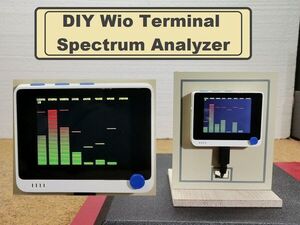
DIY Wio Terminal Spectrum Analyzer (Arduino IDE)
"The Wio Terminal is a SAMD51-based microcontroller with Wireless Connectivity compatible with Arduino and MicroPython. It runs at 120MHz, 4MB External Flash and 192KB RAM. The Wio Terminal itself is equipped with a 2.4” LCD Screen, onboard IMU (Acceleromete, Microphone, Buzzer, microSD card slot, Light sensor, and Infrared Emitter. Also it have three buttons, one five way switch (joystick), and reset switch. It supports both Bluetooth and Wi-Fi providing backbone for IoT projects. There is also a 40-pin connector on the back that connects external components and modules." [...]

Cat Prank
"Cat Prank is meowing box when discovered emits the angry cat to startle your gullible foe. The idea is to place the Cat Prank say under the sink in the bathroom or kitchen, then trigger the meows sounds remotely when you target is close by. They hear gentle kitten meows causing confusion. The meows grow louder as your target locates the source. They open the the cabinet door with the strange expectation of finding playful kittens only to be greeted by a loud hissing angry cat! The angry cat is triggered either by the light sensor or infrared motion sensor." [...]
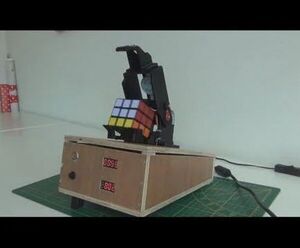
Rubik Cube Solver Robot, With Raspberry Pi and Picamera
"This robot detects and solves a 3x3 Rubik cube, tipically within 1 minute. It uses a Raspberry pi and a PiCamera. The robot works autonomously, or by sharing graphical info with a screen (or PC) All coded in Python, also the solver made available by Mr. Kociemba (https://www.speedsolving.com/threads/3x3x3-solver-in-python.64887/) who I like to thank. For the vision part I've used CV2 python library. The exact same python script also works on PC with webcam, to detect the cube status and to obtain the suggested moves by the solver. " [...]

Rick & Morty Steampunk weather gadget
"Weather station with remote outdoor sense, FM radio, blinkey lights and secret hidden compartment. Woodworker/ retired industrial automation engineer on steampunk kick. Have designed Rick & Morty gadgets and now want to take it to the next level. Bought one of the full kits and wanted to see how far I could push it. Along the way I had to invent connector shrouds, cable holders, and lots of different 3D printed mounting hardware. Once the wiring was decided and the mounts created the main components were mounted on a 112x1 piece of scrap lexan." [...]

DIY 60W PD Power Bank With Arduino Real Time Battery Info Display
"Recently, I was planning to get a 60W PD power bank for my laptop so that I don't need to worry about my laptop running out of battery during lectures. However, all the 60W power bank on the market are bulk and expensive. That is why I decided to make my own. While I was designing the power bank, I thought to myself, why can't I make one with a real time battery display? That is why I started this project: A 60W PD power bank with real time battery information display! To make this power bank, you will need some general parts that you might have already lying around in your home workshop." [...]
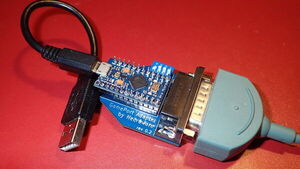
Necroware's GamePort Adapter
"Many people from the retro community still have their beloved joysticks and gamepads from the early days. These devices often live their lives somewhere in the dark corners of our basements and we don't dare to throw them away, because of nostalgic reasons. They remind us so much of our childhoods, where we played our Wing Commanders, X-Wings, Descents and many other games. These old joysticks were all made to be connected to the game port, usually on a sound card. But by the end of 90's and beginning of 2000's game ports vanished from our computers and were replaced by USB and our old joysticks disappeared into the past. Today not everybody has a full retro PC and many people are using their modern computer with DOSBox to play the old games, sometimes with a modern USB joystick." [...]
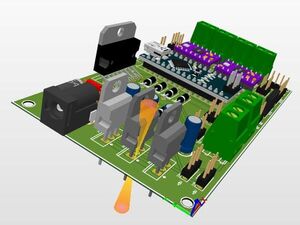
All In One Arduino PCB Board Design
"A single Arduino board is used to connect different loads at a time for different purposes. The All in one Arduino board is designed to provide the facility to the users of doing multiple projects at a time with efficiency. Those who are doing projects on Arduino can understand the need for this board. If u try to connect multiple components to the Arduino it will not work efficiently with all components at a time with either 5V or 9V regulator, you have to do it turn by turn otherwise you will not get accurate results. While with this Arduino board a user can easily connect more than 2 or 3 loads or components at a time, for instance, multiple stepper motors, multiple fans or bulbs, etc. It provides a wide range of voltages from 5V to 24V for different purposes." [...]
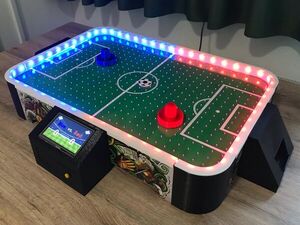
Air Football
"Fan of football but like to play air hockey? Air football is the perfect combination for you! As a part of my exchange programme in Creative Design & Technology at Saxion University in the Netherlands, I created an Air Football. The product is a result of project on 8 weeks, and I chose to make my showcase as a complete DIY tutorial which ended up in this post. The project's purpose was to extend both creative and technical skills which I did by ex. researching, ideating, developing concepts, user testing, learning SolidWorks, learning how to work with a Nextion display, and furthermore extending my skills in 3D printing, laser cutting, programming in Arduino IDE, and much more." [...]

PCB Necklace V1
"Made a wearable Small Necklace or pendant with custom Tear shaped PCB and Attiny13A The goal here was simple, to make a small Blinky board that can be attached to a chain so we can wear it like a locket or pendant. There are a total of 24 LEDs in this Pendant, I've divided LEDs into pairs of 4. This means 6 LEDs are connected in parallel and they are driven by a single AO3400 N channel mosfet. there are a total of 4 of these which control 6 LED segments each. These 4 MOSFETs are then controlled by an Attiny13A, I've added a button with its D4 Pin which starts the LED sequence. Materials: - 0603 Blue LEDs x24 - Custom PCB which was provided by PCBWAY - Attiny13A - AO3400 N channel mosfet x4 - 10K 0603 Resistor x4 - SMD Coin Cell holder CR2032" [...]
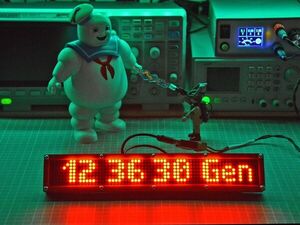
(Yet Another) Dot Matrix Clock
"A simple and eye-catching Dot Matrix Clock/Calendar showing also temperature and Humidity with a practical 3D-printed enclosure This is a very simple yet large Dot-Matrix Clock-Calendar running MD_Parola library. Many friends seen this clock in my garage and in my Instagram stories: they liked a lot so they convinced me to publish the project here even if a Dot Matrix Clock is nothing new for most of us. I've (very slightly) redesigned the standard font and designed a simple enclosure. I wrote some info here too for making the library used in this project more understandable since probably is not the simplest one for driving led matrixes: it has a lot of features and effects (it manage sprites too!). So, even if this clock is something you already seen a lot of times, probably you'll read something new and you'll have some more clues. Overview This clock is based on a NodeMCU (ESP8266) so WiFi is used for setting the right time from a NTP server without user intervention." [...]
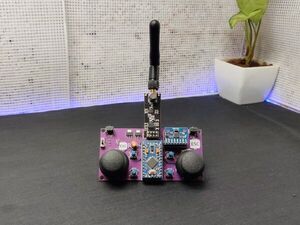
Multifunctional rc transmitter using arduino
"Lets build a NRF transmitter using arduino In this tutorial, I am showing how to build a MULTIFUNCTIONAL RC TRANSMITTER USING ARDUINO. This nrf transmitter consists of 2 joysticks 6 buttons switches and a gyroscope. so we can use this transmitter to control different RC projects. now let's get started Arduino Pro MiniThe Arduino Pro Mini is a microcontroller board based on the ATmega328.It has 14 digital input/output pins (of which 6 can be used as PWM outputs), 6 analogue inputs, an onboard resonator, a reset button, and holes for mounting pin headers. A six pin header can be connected to an FTDI cable or Sparkfun breakout board to provide USB power and communication to the board. The Arduino Pro Mini is intended for semi-permanent installation in objects or exhibitions." [...]

All-purpose Power Micro Controller
"This general-purpose power micro controller features: - Wheatstone Bridge front-end - New Texas Instruments INA823 instrumentation amplifier - Accurate Texas Instruments REF2030 1.5/3V dual reference voltage source (<0.05%, 1.5 ppm/°C typ.) - 48-pin STM32G0B1CE 512kB Flash, 144 kB RAM MPU - Popular Waveshare 18179 128x64 1.3" OLED display - STLINK-V3 mini and STLINK-V2 debug connectors, Segger J-Link mini supported. - Rotary encoder and EEPROM - Small dimensions - only 85x50mm Optional components: - USB socket, can be used as a power source - Real Time Clock (RTC) with quartz crystal oscillator - Miniature battery or supercapacitor for RTC and memory backup - Opto-isolated serial port (RX/TX) - I2C port - Two buffered DACs - Larger Waveshare 14747 128x128 1.5" RGB OLED display - Two potentiometers for fine-tuning (gain and zero) The device has been designed to be easily configured - e.g. here as a Weller WSP80 station/controller powered from a standard 30V/5A bench power supply. I have built this universal controller to test some design concepts and have used it intensively for over a year as a Weller WSP80 soldering iron controller. Published schematic includes probably the final 3rd version, slightly improved over what is presented on the pictures (2nd version)." [...]

Lcd-Meter
"Measuring temperature and humidity featuring LC display and webserver upload using Arduino with Ethernet shield, LCD and realtime clock This project consists of two parts: an Arduino-based module to measure temperature and humidity and sending these data to a webserver, plus a simple server-side php webpage to display and archive the measurements. Components used: The Lcd-Meter project uses an Arduino UNO or similar, together with an Ethernet shield (W5100 type), a DHT22 temperature/humidity sensor, a DS3231 realtime clock module, and a 16x2 LCD module. The latter two are connected by I2C, while the Ethernet module uses SPI and the DHT22 sensor is connected via 1-wire protocol. " [...]
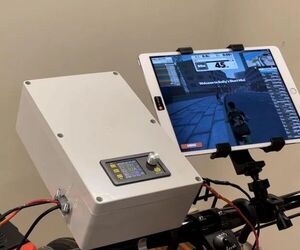
Zwift Capable Pedal Generator
"I've been using a pedal generator for a few years now during the winter months, but this year decided to sign up with Zwift and see if I could integrate my pedal generator with Zwift. This Instructable will show how I tied my pedal generator and a charge controller to Zwift using an Arduino Nano 33 IoT. Zwift now controls the wattage (resistance) through the Arduino using the Bluetooth Low Energy Fitness Machine Service. Some history first... I initially built the Zwift integration Arduino code using the Cycle Power Service, and was able to report the wattage to Zwift this way. A good first step, but was not the "full experience" of Zwift." [...]
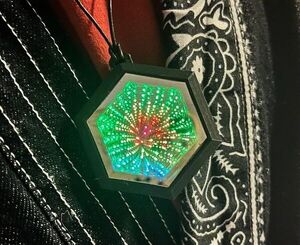
Hex Infinity Mirror Pendant
"This instructables show how to use an Hex NeoPixel board to build an Hex Infinity Mirror Pendant. Supplies: - ATtiny45-20SU (and ISP programmer) - HEX NeoPixel LED Board - 10 mm LED Touch Switch - Four 360819 Lipo Batteries - 0.5 mm Two Way Mirror Acrylic Sheet - Super Mini Lithium Battery Charging Board - 28 mm Qi Standard Wireless Charging Receiver Module - Some wires - 1.27 mm Pitch General Purpose PCB Board (optional) - Some pin headers (optional)" [...]
Secção Videos
Videos interessantes.
That's all Folks!



